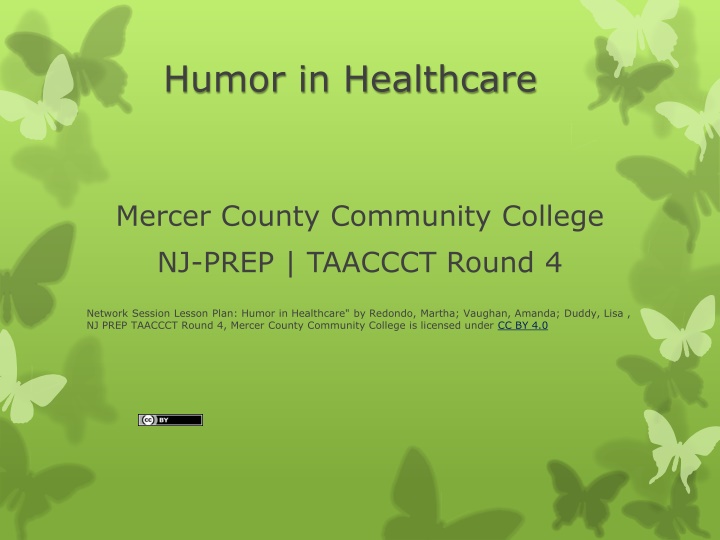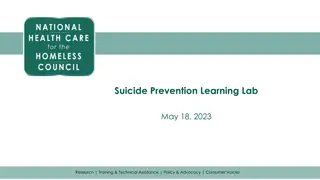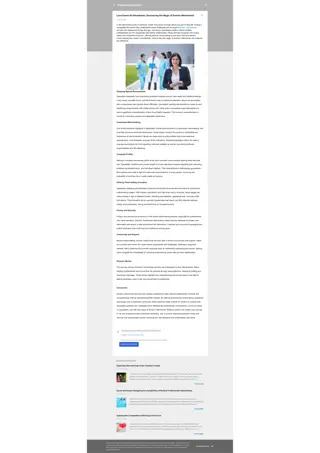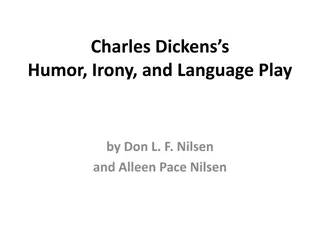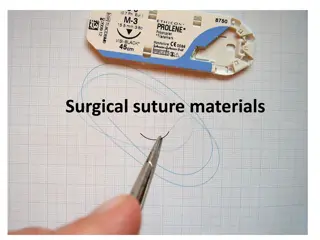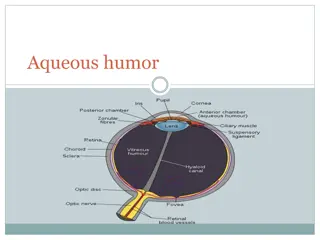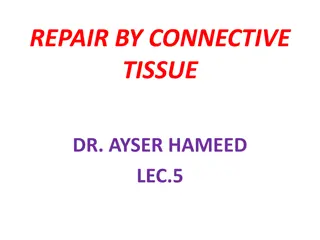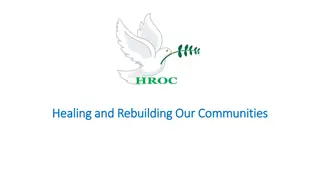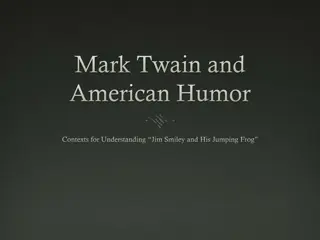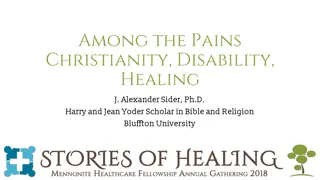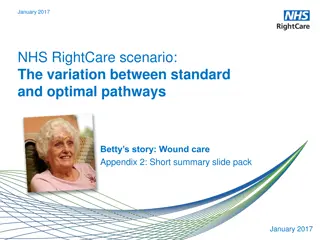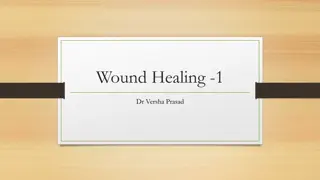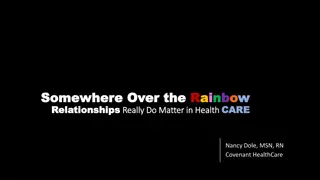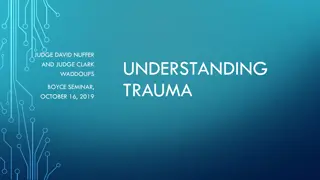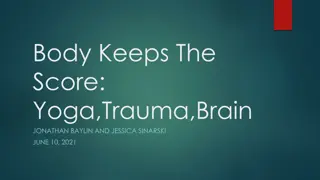Humor in Healthcare: Promoting Healing and Engagement
Humor plays a crucial role in healthcare, fostering healing even in critical situations. This lesson plan explores the benefits of humor in healthcare, such as improving patient-provider engagement, promoting team cohesion, and enhancing overall well-being. Learning objectives include encouraging the use of humor to alleviate stress, educating on the health benefits of laughter, and providing strategies for appropriate humor usage in healthcare settings. Activities like playing board games and understanding the physical effects of laughter are incorporated to enhance the learning experience.
Download Presentation

Please find below an Image/Link to download the presentation.
The content on the website is provided AS IS for your information and personal use only. It may not be sold, licensed, or shared on other websites without obtaining consent from the author.If you encounter any issues during the download, it is possible that the publisher has removed the file from their server.
You are allowed to download the files provided on this website for personal or commercial use, subject to the condition that they are used lawfully. All files are the property of their respective owners.
The content on the website is provided AS IS for your information and personal use only. It may not be sold, licensed, or shared on other websites without obtaining consent from the author.
E N D
Presentation Transcript
Humor in Healthcare Mercer County Community College NJ-PREP | TAACCCT Round 4 Network Session Lesson Plan: Humor in Healthcare" by Redondo, Martha; Vaughan, Amanda; Duddy, Lisa , NJ PREP TAACCCT Round 4, Mercer County Community College is licensed under CC BY 4.0
Humor in Healthcare (continued) Humor can play an integral part in the in the healing process even in intensive care situations and end of life care. Humor plays an essential role in promoting team engagement among healthcare providers.
Learning Objectives 1. After completing the lesson, students will be able to: 2. Encourage engagement between patient and healthcare worker using humor. 3. Understand the application of humor in healthcare situations. 4. Understand the appropriate use of utilizing humor in the healthcare setting. 5. Be able to inform patients of the health benefits of laughter, humor, happiness and joy to improve health outcomes. 6. To encourage patients to use humor to take the focus away from their health issues momentarily.
Take a break and play board game.
Icebreaker Board Game Play time 20 minutes
Laughter Can Physically Change the Body Increase Blood Circulation Ventilates Lungs Increased Oxygen Intake Decreases Risk of Pulmonary Infection Strengthen the Immune System Boost Energy Alleviate Pain Protect Against the Damaging Effects of Stress
Laughter is Infectious You as the health provider can spark laughter in the patients you provide care to.
Strategies for Utilizing Humor in the Healthcare Setting 1. Gauge the other persons sense of humor. Consider: a. learning style b. age c. culture d. gender 2. Use humor to act as a bridge to teaching. 3. When in doubt - don t say it. a. Use humor in small doses at first b. If there is bad news coming, do not use humor c. If a person is angry, use caution 4. Be able to recover when humor backfires a. Apologize if humor fall flat b. If someone directs an inappropriate humorous comment at you, do not over react - perhaps say that is a creative way of looking at things.
What to Keep in Mind 1. People have individualized senses of humor. What makes one person laugh might annoy or insult someone else. 2. In the healthcare setting, it is possible that pleasant patients may receive better care than do grumpy/ hostile patients. 3. Humor, if used inappropriately creates the potential to create distance and prevent serious discussion. So it is important to constantly gauge the situation.
What to Keep in Mind (continued) 4. If laughter enhances the immune system it is important to be cautious in situations where immune reaction is contingent in the healing process. 5. Be positive in your use of humor to help your patient feel better.
Types of Humor Positive Humor (Advised to use). Humor which makes people feel connected. Negative Humor (Not advised to use). Humor which makes people feel excluded. Sarcasm Remember that sarcasm can be hurtful or misunderstood (not to be used with new relations, whose sense of humor is unknown). Inside Humor A key phrase that is understood within a select number or people. Cannot be used with anyone outside the in-group.
Types of Humor (continued) Stereotypic Humor (Not advised to use). Negatively reinforces a stereotype. Ethnic Humor (Not advised to use). It is not fun if you are a member of the ethnicity at the end of the joke. Sexual Humor (Not advised to use). Not only can you offend someone, you can also be handed a sexual harassment lawsuit. Dark/Sick Humor (Not advised to use). The closer you are to tragedy and death, the darker humor becomes. Your patients may use it when speaking to you. Dark humor aids some in dealing with stress and anxiety.
Case: Norman Cousins In 1979, Norman Cousins, editor of the Saturday Review of Literature, published his best-selling Anatomy of an Illness. He had a serious collagen disease that affected the connective tissue of his spine and joints. The disease was life-threatening, his pain was intense, and the doctors gave him little hope for a full recovery. He was frustrated by the hospital routines and his slow progress, so he checked himself out of the hospital and into a nearby hotel.
Case: Norman Cousins (continued) Because of his celebrity status, the doctors visited him and delivered his medication, while he used humor- intervention therapy. He read humorous books, and watched funny movies, and tapes of TV s Candid Camera. He found that the more he laughed, the longer his body was without pain. He persuasively made the case that if it is possible to have a psychosomatic illness, then it is also possible to have a psychosomatic wellness.
Psychosomatic Definition: (of a physical illness or other condition) caused or aggravated by a mental factor such as internal conflict or stress. https://www.google.com/search?q=definition+of+psychocomantic&ie=utf-8&oe=utf-8
Empirical Evidence Dr. WILLIAM FRY | Stanford University Medical School In 1971 began empirical studies on the effects of humor and laughter. He went beyond anecdotal stories by objectively testing and measuring physical responses to humor. He found that the chemical compositions of tears are different when a person is laughing as compared to crying. Dr. Fry showed that people s bodies are tense when listening to a joke, but relaxed at the end. He compared the body s production of dopamine when laughing to a runner s high, which is why he calls laughter Internal Jogging
Empirical Evidence Dr. WILLIAM FRY, Stanford University s Medical School (continued) Humorous laughter lowers the level of stress hormones (epinephrine, cortisol, dopac, and growth hormone). In the brain, catecholamines are secreted, which may increase alertness, reduce inflammation, and trigger the release of endorphins, the brain s natural opiates. This may account for the reduction of pain as reported by researchers including Norman Cousins.
Life Long Learning in Healthcare Definition: The provision or use of both formal and informal learning opportunities throughout people's lives in order to foster the continuous development and improvement of the knowledge and skills needed for employment and personal fulfilment https://www.google.com/search?q=lifelong+learning+definition&ie=utf-8&oe=utf-8
Life Long Learning in Healthcare (continued) As a health professional you must to commit to lifelong learning. Keep credentials, certifications up to date. You have worked hard to achieve these credentials. Use them to propel yourself into additional education and achievements. Investigate college pathways to further advance your career. Seek out additional certification programs to increase skills. Investigate Prior Learning Assessment (PLA) programs to see if your credentials allow you to earn college credit which can be applied toward college courses and degree programs. See your community college offerings in PLA.
References Benmoussaiman. (n/a) Let s Talk About Health. Board game. Busy Teacher: Free Printable Worksheets for Teachers like YOU! Retrieved April 28, 2016, from http://busyteacher.org/19251-lets-talk-about-health.html Blackwell, W. (2008). Humor Plays an Important Role in Healthcare Even When Patients Are Terminally Ill. Retrieved April 28, 2016, from https://www.sciencedaily.com/releases/2008/04/080408112104.htm Buxman, K. (n.d.). Types of Humor: The Good, The Bad, and the Sometimes Ugly. Retrieved April 26, 2016, from https://aath.memberclicks.net/assets/docs/HumorResources/thegoodkarynaathhr.%20pdf Nilsen, A., & Nilsen, D. (2016). Health and Humor [PPT]. Arizona State University. Retrieved April 26, 2016, from http://webcache.googleusercontent.com/search?q=cache:fQ2W6nl_IWIJ:www.public.asu.ed u/~dnilsen/documents/humor-health.ppt+&cd=1&hl=en&ct=clnk&gl=us Osborne, H. (2013). Health Literacy from A to Z: Practical Ways to Communicate to Your Health Message 2nd. Humor and Healing, pgs. 77-80. Network Session Lesson Plan: Humor in Healthcare" by Redondo, Martha; Vaughan, Amanda; Duddy, Lisa , NJ PREP TAACCCT Round 4, Mercer County Community College is licensed under CC BY 4.0 This workforce product was funded by a $15,000,000 grant awarded by the U.S. Department of Labor s Employment and Training Administration. The product was created by the grantee and does not necessarily reflect the official position of the U.S. Department of Labor. The U.S. Department of Labor makes no guarantees, warranties, or assurances of any kind, express or implied, with respect to such information, including any information on linked sites and including, but not limited to, accuracy of the information or its completeness, timeliness, usefulness, adequacy, continued availability, or ownership.
